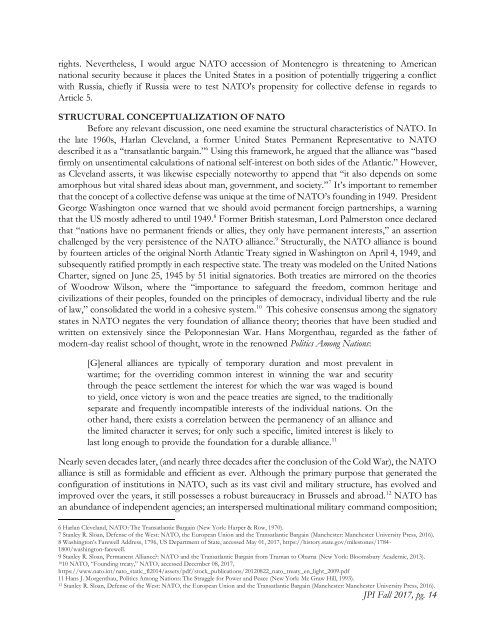Fall 2017 JPI
Create successful ePaper yourself
Turn your PDF publications into a flip-book with our unique Google optimized e-Paper software.
ights. Nevertheless, I would argue NATO accession of Montenegro is threatening to American<br />
national security because it places the United States in a position of potentially triggering a conflict<br />
with Russia, chiefly if Russia were to test NATO's propensity for collective defense in regards to<br />
Article 5.<br />
STRUCTURAL CONCEPTUALIZATION OF NATO<br />
Before any relevant discussion, one need examine the structural characteristics of NATO. In<br />
the late 1960s, Harlan Cleveland, a former United States Permanent Representative to NATO<br />
described it as a “transatlantic bargain.” 6 Using this framework, he argued that the alliance was “based<br />
firmly on unsentimental calculations of national self-interest on both sides of the Atlantic.” However,<br />
as Cleveland asserts, it was likewise especially noteworthy to append that “it also depends on some<br />
amorphous but vital shared ideas about man, government, and society.” 7 It’s important to remember<br />
that the concept of a collective defense was unique at the time of NATO’s founding in 1949. President<br />
George Washington once warned that we should avoid permanent foreign partnerships, a warning<br />
that the US mostly adhered to until 1949. 8 Former British statesman, Lord Palmerston once declared<br />
that “nations have no permanent friends or allies, they only have permanent interests,” an assertion<br />
challenged by the very persistence of the NATO alliance. 9 Structurally, the NATO alliance is bound<br />
by fourteen articles of the original North Atlantic Treaty signed in Washington on April 4, 1949, and<br />
subsequently ratified promptly in each respective state. The treaty was modeled on the United Nations<br />
Charter, signed on June 25, 1945 by 51 initial signatories. Both treaties are mirrored on the theories<br />
of Woodrow Wilson, where the “importance to safeguard the freedom, common heritage and<br />
civilizations of their peoples, founded on the principles of democracy, individual liberty and the rule<br />
of law,” consolidated the world in a cohesive system. 10 This cohesive consensus among the signatory<br />
states in NATO negates the very foundation of alliance theory; theories that have been studied and<br />
written on extensively since the Peloponnesian War. Hans Morgenthau, regarded as the father of<br />
modern-day realist school of thought, wrote in the renowned Politics Among Nations:<br />
[G]eneral alliances are typically of temporary duration and most prevalent in<br />
wartime; for the overriding common interest in winning the war and security<br />
through the peace settlement the interest for which the war was waged is bound<br />
to yield, once victory is won and the peace treaties are signed, to the traditionally<br />
separate and frequently incompatible interests of the individual nations. On the<br />
other hand, there exists a correlation between the permanency of an alliance and<br />
the limited character it serves; for only such a specific, limited interest is likely to<br />
last long enough to provide the foundation for a durable alliance. 11<br />
Nearly seven decades later, (and nearly three decades after the conclusion of the Cold War), the NATO<br />
alliance is still as formidable and efficient as ever. Although the primary purpose that generated the<br />
configuration of institutions in NATO, such as its vast civil and military structure, has evolved and<br />
improved over the years, it still possesses a robust bureaucracy in Brussels and abroad. 12 NATO has<br />
an abundance of independent agencies; an interspersed multinational military command composition;<br />
6 Harlan Cleveland, NATO: The Transatlantic Bargain (New York: Harper & Row, 1970).<br />
7 Stanley R. Sloan, Defense of the West: NATO, the European Union and the Transatlantic Bargain (Manchester: Manchester University Press, 2016).<br />
8 Washington’s Farewell Address, 1796, US Department of State, accessed May 01, <strong>2017</strong>, https://history.state.gov/milestones/1784-<br />
1800/washington-farewell.<br />
9 Stanley R. Sloan, Permanent Alliance?: NATO and the Transatlantic Bargain from Truman to Obama (New York: Bloomsbury Academic, 2013).<br />
1010 NATO, “Founding treaty,” NATO, accessed December 08, <strong>2017</strong>,<br />
https://www.nato.int/nato_static_fl2014/assets/pdf/stock_publications/20120822_nato_treaty_en_light_2009.pdf<br />
11 Hans J. Morgenthau, Politics Among Nations: The Struggle for Power and Peace (New York: Mc Graw Hill, 1993).<br />
12 Stanley R. Sloan, Defense of the West: NATO, the European Union and the Transatlantic Bargain (Manchester: Manchester University Press, 2016).<br />
<strong>JPI</strong> <strong>Fall</strong> <strong>2017</strong>, pg. 14
















